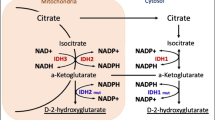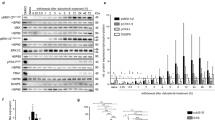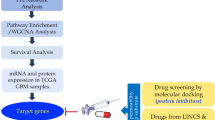Abstract
Purpose
Glioblastoma (GBM) is a rapidly growing tumor in the central nervous system with altered metabolism. Depleting the bioenergetics of tumors with biguanides have been suggested as an effective therapeutic approach for treating GBMs. The purpose of this study was to determine the effects of IM1761065, a novel biguanide with improved pharmacokinetics, on GBM-tumorspheres (TSs).
Methods
The biological activities of IM1761065 on GBM-TSs, including their effects on viability, ATP levels, cell cycle, stemness, invasive properties, and transcriptomes were examined. The in vivo efficacy of IM1761065 was tested in a mouse orthotopic xenograft model.
Results
IM1761065 decreased the viability and ATP levels of GBM-TSs in a dose-dependent manner, and reduced basal and spare respiratory capacity in patient-derived GBM-TS, as measured by the oxygen consumption rate. Sphere formation, expression of stemness-related proteins, and invasive capacity of GBM-TSs were also significantly suppressed by IM1761065. A gene-ontology comparison of IM1761065-treated groups showed that the expression levels of stemness-related, epithelial mesenchymal transition-related, and mitochondrial complex I genes were also significantly downregulated by IM1761065. An orthotopic xenograft mouse model showed decreased bioluminescence in IM1761065-treated cell-injected mice at 5 weeks. IM1761065-treated group showed longer survival than the control group (P = 0.0289, log-rank test).
Conclusion
IM1761065 is a potent inhibitor of oxidative phosphorylation. The inhibitory effect of IM1761065 on the bioenergetics of GBM-TS suggests that this novel compound could be used as a new drug for the treatment of GBM.





Similar content being viewed by others
Abbreviations
- 3D:
-
Three-dimensional
- EMT:
-
Epithelial-mesenchymal transition
- GBM:
-
Glioblastoma
- PI:
-
Propidium iodide
- SDS-PAGE:
-
Sodium dodecyl sulfate–polyacrylamide gel electrophoresis
- TS:
-
Tumorsphere
References
Hegi ME, Diserens AC, Gorlia T, Hamou MF, de Tribolet N, Weller M et al (2005) MGMT gene silencing and benefit from temozolomide in glioblastoma. N Engl J Med 352:997–1003
Stupp R, Hegi ME, Mason WP, van den Bent MJ, Taphoorn MJ, Janzer RC et al (2009) Effects of radiotherapy with concomitant and adjuvant temozolomide versus radiotherapy alone on survival in glioblastoma in a randomised phase III study: 5-year analysis of the EORTC-NCIC trial. Lancet Oncol 10:459–466
Roh TH, Park HH, Kang S-G, Moon JH, Kim EH, Hong C-K et al (2017) Long-term outcomes of concomitant chemoradiotherapy with temozolomide for newly diagnosed glioblastoma patients: a single-center analysis. Medicine 96:e7422
Patel AP, Tirosh I, Trombetta JJ, Shalek AK, Gillespie SM, Wakimoto H et al (2014) Single-cell RNA-seq highlights intratumoral heterogeneity in primary glioblastoma. Science 344:1396–1401
Dagogo-Jack I, Shaw AT (2017) Tumour heterogeneity and resistance to cancer therapies. Nat Rev Clin Oncol 15:81–94
Kang S-G, Cheong J-H, Huh YM, Kim EH, Kim SH, Chang JH (2015) Potential use of glioblastoma tumorsphere: clinical credentialing. Arch Pharm Res 38:402–407
Nakano I (2014) Stem cell signature in glioblastoma: therapeutic development for a moving target. J Neurosurg 122:324–330
Choi J, Lee J-H, Koh I, Shim J-K, Park J, Jeon JY et al (2016) Inhibiting stemness and invasive properties of glioblastoma tumorsphere by combined treatment with temozolomide and a newly designed biguanide (HL156A). Oncotarget 7:65643–65659
Park J, Shim J-K, Kang JH, Choi J, Chang JH, Kim S-Y et al (2018) Regulation of bioenergetics through dual inhibition of aldehyde dehydrogenase and mitochondrial complex I suppresses glioblastoma tumorspheres. Neuro-Oncol 20:954–965
Pollak M (2010) Metformin and other biguanides in oncology: advancing the research agenda. Cancer Prev Res (Phila Pa) 3:1060–1065
Pollak M (2013) Potential applications for biguanides in oncology. J Clin Invest 123:3693–3700
Noto H, Tsujimoto T, Sasazuki T, Noda M (2011) Significantly increased risk of cancer in patients with diabetes mellitus: a systematic review and meta-analysis. Endocr Pract 17:616–628
Giovannucci E, Harlan DM, Archer MC, Bergenstal RM, Gapstur SM, Habel LA et al (2010) Diabetes and cancer. Diabetes Care 33:1674–1685
Evans JMM, Donnelly LA, Emslie-Smith AM, Alessi DR, Morris AD (2005) Metformin and reduced risk of cancer in diabetic patients. BMJ 330:1304–1305
Noto H, Goto A, Tsujimoto T, Noda M (2012) Cancer risk in diabetic patients treated with metformin: a systematic review and meta-analysis. PLOS ONE 7:e33411
Landman GWD, Kleefstra N, van Hateren KJJ, Groenier KH, Gans ROB, Bilo HJG (2010) Metformin associated with lower cancer mortality in type 2 diabetes: ZODIAC-16. Diabetes Care 33:322–326
Song CW, Lee H, Dings RPM, Williams B, Powers J, Santos TD et al (2012) Metformin kills and radiosensitizes cancer cells and preferentially kills cancer stem cells. Sci Rep 2:362
Kim EH, Lee J-H, Oh Y, Koh I, Shim J-K, Park J et al (2017) Inhibition of glioblastoma tumorspheres by combined treatment with 2-deoxyglucose and metformin. Neuro Oncol 19:197–207
Kong BH, Park N-R, Shim J-K, Kim B-K, Shin H-J, Lee J-H et al (2013) Isolation of glioma cancer stem cells in relation to histological grades in glioma specimens. Childs Nerv Syst 29:217–229
Kwak J, Shin H-J, Kim S-H, Shim J-K, Lee J-H, Huh Y-M et al (2013) Isolation of tumor spheres and mesenchymal stem-like cells from a single primitive neuroectodermal tumor specimen. Childs Nerv Syst 29:2229–2239
Kwak J, Shim J-K, Kim DS, Lee J-H, Choi J, Park J et al (2016) Isolation and characterization of tumorspheres from a recurrent pineoblastoma patient: feasibility of a patient-derived xenograft. Int J Oncol 49:569–578
Yu G, Wang LG, Han Y, He QY (2012) ClusterProfiler: an R package for comparing biological themes among gene clusters. OMICS 16:284–287
Xia W, Lo CM, Poon RYC, Cheung TT, Chan ACY, Chen L et al (2017) Smad inhibitor induces CSC differentiation for effective chemosensitization in cyclin D1- and TGF-β/Smad-regulated liver cancer stem cell-like cells. Oncotarget 8:38811–38824
Couturier CP, Ayyadhury S, Le PU et al (2020) Single-cell RNA-seq reveals that glioblastoma recapitulates a normal neurodevelopmental hierarchy. Nat Commun 11:3406. https://doi.org/10.1038/s41467-020-17186-5
Liu X, Wang L, Cui W, Yuan X, Lin L, Cao Q et al (2016) Targeting ALDH1A1 by disulfiram/copper complex inhibits non-small cell lung cancer recurrence driven by ALDH-positive cancer stem cells. Oncotarget 7(36):58516–58530
Natale CA, Li J, Zhang J, Dahal A, Dentchev T, Stanger BZ et al (2018) Activation of G protein-coupled estrogen receptor signaling inhibits melanoma and improves response to immune checkpoint blockade. eLife 7:e31770
Wang Y, Xu H, Fu W, Lu Z, Guo M, Wu X et al (2019) 20(S)-Protopanaxadiol inhibits angiotensin II-induced epithelial- mesenchymal transition by downregulating SIRT1. Front Pharmacol 10:475
Oh H-C, Shim J-K, Park J et al (2020) Combined effects of niclosamide and temozolomide against human glioblastoma tumorspheres. J Cancer Res Clin Oncol 146:2817–2828
Lal S, Lacroix M, Tofilon P, Fuller GN, Sawaya R, Lang FF (2000) An implantable guide-screw system for brain tumor studies in small animals. J Neurosurg 92:326–333
Pastrana E, Silva-Vargas V, Doetsch F (2011) Eyes wide open: a critical review of sphere-formation as an assay for stem cells. Cell Stem Cell 8:486–498. https://doi.org/10.1016/j.stem.2011.04.007
Stupp R, Mason WP, van den Bent MJ, Weller M, Fisher B, Taphoorn MJB et al (2005) Radiotherapy plus concomitant and adjuvant temozolomide for glioblastoma. N Engl J Med 352:987–996
Bao S, Wu Q, McLendon RE, Hao Y, Shi Q, Hjelmeland AB et al (2006) Glioma stem cells promote radioresistance by preferential activation of the DNA damage response. Nature 444:756–760
Jackson M, Hassiotou F, Nowak A (2015) Glioblastoma stem-like cells: at the root of tumor recurrence and a therapeutic target. Carcinogenesis 36:177–185
Lee JH, Lee JE, Kahng JY, Kim SH, Park JS, Yoon SJ et al (2018) Human glioblastoma arises from subventricular zone cells with low-level driver mutations. Nature 560:243–247
Yoon S-J, Park J, Jang D-S, Kim HJ, Lee JH, Jo E et al (2019) Glioblastoma cellular origin and the firework pattern of cancer genesis from the subventricular zone. J Korean Neurosurg Soc 63:26–33
Hsu PP, Sabatini DM (2008) Cancer cell metabolism: Warburg and beyond. Cell 134:703–707
Warburg O (1927) The metabolism of tumors in the body. J Gen Physiol 8:519–530
Bonuccelli G, Whitaker-Menezes D, Castello-Cros R, Pavlides S, Pestell RG, Fatatis A et al (2010) The reverse Warburg effect: glycolysis inhibitors prevent the tumor promoting effects of caveolin-1 deficient cancer associated fibroblasts. Cell Cycle 9:1960–1971
Pavlides S, Whitaker-Menezes D, Castello-Cros R, Flomenberg N, Witkiewicz AK, Frank PG et al (2009) The reverse Warburg effect: aerobic glycolysis in cancer associated fibroblasts and the tumor stroma. Cell Cycle 8:3984–4001
Fu Y, Liu S, Yin S, Niu W, Xiong W, Tan M et al (2017) The reverse Warburg effect is likely to be an Achilles’ heel of cancer that can be exploited for cancer therapy. Oncotarget 8:57813–57825
Kasznicki J, Sliwinska A, Drzewoski J (2014) Metformin in cancer prevention and therapy. Ann Transl Med 2:57
Chae YK, Arya A, Malecek M-K, Shin DS, Carneiro B, Chandra S et al (2016) Repurposing metformin for cancer treatment: current clinical studies. Oncotarget 7:40767–40780
Ucbek A, Özünal ZG, Uzun Ö, Gepdİremen A (2014) Effect of metformin on the human T98G glioblastoma multiforme cell line. Exp Ther Med 7:1285–1290
Sato A, Sunayama J, Okada M, Watanabe E, Seino S, Shibuya K et al (2012) Glioma-initiating cell elimination by metformin activation of FOXO3 via AMPK. Stem Cells Transl Med 1:811–824
Seliger C, Meyer A-L, Renner K, Leidgens V, Moeckel S, Jachnik B et al (2016) Metformin inhibits proliferation and migration of glioblastoma cells independently of TGF-β2. Cell Cycle 15:1755–1766
Würth R, Pattarozzi A, Gatti M, Bajetto A, Corsaro A, Parodi A et al (2013) Metformin selectively affects human glioblastoma tumor-initiating cell viability. Cell Cycle 12:145–156
Valtorta S, Dico AL, Raccagni I, Gaglio D, Belloli S, Politi LS et al (2017) Metformin and temozolomide, a synergic option to overcome resistance in glioblastoma multiforme models. Oncotarget 8:113090–113104
Sesen J, Dahan P, Scotland SJ, Saland E, Dang V-T, Lemarié A et al (2015) Metformin inhibits growth of human glioblastoma cells and enhances therapeutic response. PLoS ONE 10:e0123721
Owen MR, Doran E, Halestrap AP (2000) Evidence that metformin exerts its anti-diabetic effects through inhibition of complex 1 of the mitochondrial respiratory chain. Biochem J 348:607–614
Sahra IB, Regazzetti C, Robert G, Laurent K, Marchand-Brustel YL, Auberger P et al (2011) Metformin, independent of AMPK, induces mTOR inhibition and cell-cycle arrest through REDD1. Cancer Res 71:4366–4372
Acknowledgements
We thank Prof. Lang (Department of Neurosurgery, M. D. Anderson Cancer Center, The University of Texas, Houston, Texas, USA) for providing patient derived GBM tumorspheres (GSC11). IM1761065 was provided by ImmunoMet Therapeutics (Houston, Texas, USA).
Funding
This work was supported by a National Research Foundation of Korea (NRF) Grant funded by the Korean government (MSIT) (NRF-2019R1A2C3004155) and the Bio & Medical Technology Development Program of the NRF funded by the Ministry of Science & ICT (NRF-2020M3E5E2037960, NRF-2020M2D9A2092372, NRF-2020M3A9E8024890). This study was supported by the “Team Science Award” of Yonsei University College of Medicine (6-2021-0006).
Author information
Authors and Affiliations
Contributions
THR, JHL, JKS, and SGK conceptualized and initiated the project. JHL, SJK, and JKS performed the experiments and analyzed the data. SJY, JP, and WYT analyzed microarray and gene ontology databases. THR, JHL, SJK, JKS, SJY, and SGK drafted the manuscript. WYT, SHK, and JHC revised the manuscript critically. All authors have read and approved the manuscript.
Corresponding author
Ethics declarations
Conflict of interest
Seok-Gu Kang is a scientific advisor for ImmunoMet Therapeutics. The other authors declare no conflict of interest.
Ethical approval
All applicable international, national, and/or institutional guidelines for the care and use of animals were followed. All procedures performed in studies involving animals followed the ethical standards of the institution or practice at which the studies were conducted.
Consent for publication
Not applicable.
Additional information
Publisher's Note
Springer Nature remains neutral with regard to jurisdictional claims in published maps and institutional affiliations.
Supplementary Information
Below is the link to the electronic supplementary material.
11060_2021_3903_MOESM2_ESM.pdf
Supplementary file2 Suppl. Fig. 1 Average body weight of 5 mice after daily intraperitoneal administration of IM1761065 (10 mg/kg) for 4 weeks. Body weight did not decrease by more than 15% during this period (PDF 20 kb)
11060_2021_3903_MOESM3_ESM.pdf
Supplementary file3 Suppl. Fig. 2 Combination effect of IM1761065 and temozolomide a. Combined therapy of IM1761065 with (5 µM) temozolomide (250 µM) also significantly decreased the viability of all GBM-TSs. b. ATP levels were significantly decreased after combined treatment with IM1761065 and temozolomide (PDF 633 kb)
11060_2021_3903_MOESM4_ESM.pdf
Supplementary file4 Suppl. Fig. 3 Comparison between the effects of IM1761065 and metformin treatment on viability and ATP levels. After 72 h of treatment with 5 µM IM1761065 or 5 µM metformin, MTS and ATP assays were performed in each GBM-TS. a. Viability and b. ATP levels were significantly decreased in IM1761065-treated groups in all GBM-TSs (PDF 618 kb)
11060_2021_3903_MOESM5_ESM.pdf
Supplementary file5 Suppl. Fig. 4 Comparison between the effects of IM1761065 and metformin treatments on stemness properties After 72 h of treatment with 5 µM IM1761065, neurosphere formation assay showed a significant decrease in neurosphere formation in all the GBM-TSs than in the control and 5 µM metformin-treated GBM-TSs (PDF 544 kb)
11060_2021_3903_MOESM6_ESM.pdf
Supplementary file6 Suppl. Fig. 5 Comparison between the effects of IM1761065 and metformin treatment on invasive properties. After 72 h of treatment with 5 µM IM1761065, a three-dimensional invasion assay showed a significant decrease in invasion in U87 and U251 tumorspheres than in the control and 5 µM metformin treated tumorspheres (PDF 705 kb)
11060_2021_3903_MOESM7_ESM.pdf
Supplementary file7 Suppl. Fig. 6. Comparison between the effects of IM1761065 and other biguanide treatment on biological effect. (a) Cell viability, (b) ATP levels, (c) stemenss, and (d) invasiveness of GBM TS were evaluated after treatment with IM1761065, metformin, phenformin, and HL156A [8]. all biguanides were treated with the same concentration of 5 µM. Differences among groups were compared by one-way ANOVA with Tukey’s post hoc test; means ± SD; *P < 0.05 (PDF 61 kb)
Rights and permissions
About this article
Cite this article
Roh, T.H., Lee, JH., Kim, S.J. et al. A novel biguanide (IM1761065) inhibits bioenergetics of glioblastoma tumorspheres. J Neurooncol 156, 139–151 (2022). https://doi.org/10.1007/s11060-021-03903-7
Received:
Accepted:
Published:
Issue Date:
DOI: https://doi.org/10.1007/s11060-021-03903-7




